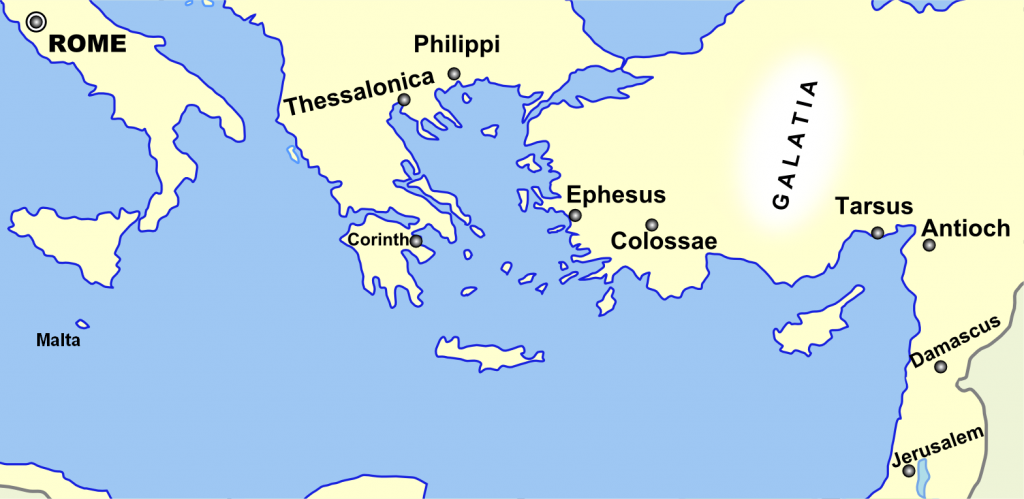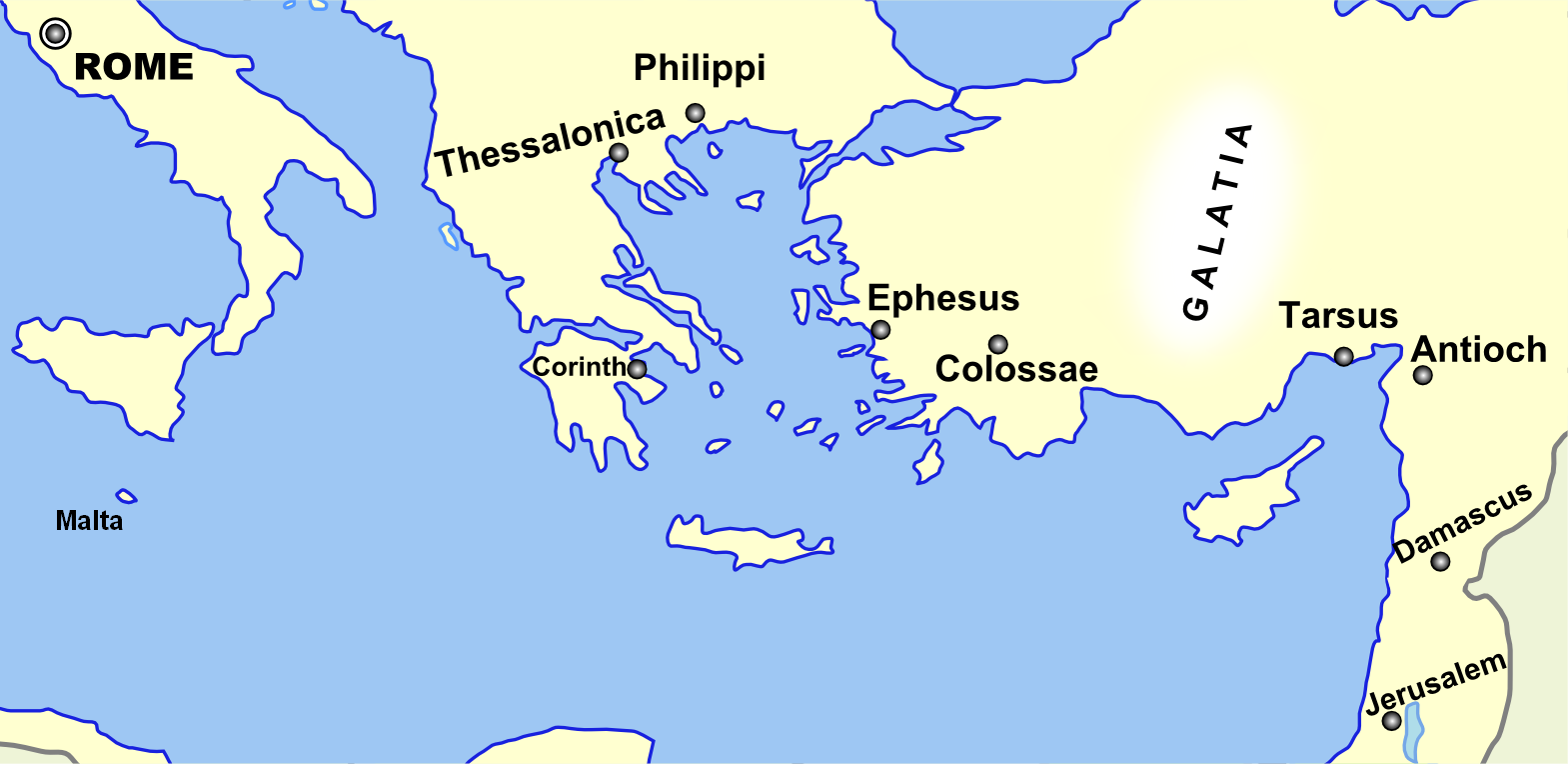
Ephesus was the capital and the largest city of the Roman Empire’s province in Asia Minor. It bore the title of “the first and greatest metropolis of Asia.”
Located at the mouth of the Cayster River, on the east side of the Aegean Sea, the city of Ephesus was perhaps best known for its magnificent temple of Artemis, or Diana, one of the 7 wonders of the ancient world. It was also an important political, educational, and commercial center, ranking with Alexandria in Egypt, and Antioch of Pisidia, in southern Asia Minor.
Ephesus was on the main route from Rome to the East, and many side roads and sea-routes converged at it ( Acts 19:21; Acts 20:1; Act 20:17, 1 Timothy 1:3 , 2 Timothy 4:12 ). It was an obvious center for the work of St. Paul, as influences from there spread over the whole province ( Acts 19:10 ). Corinth was the next great station on the way to Rome, and communication between the two places was constant.
Many Jews took up their residence in this city, and here the seeds of the gospel were sown immediately after Pentecost (Acts 2:9, 6:9). At the close of his second missionary journey (about A.D. 51), when Paul was returning from Greece to Syria (Acts 18:18-21), he first visited this city. He remained, however, for only a short time, as he was hastening to keep the feast, probably of Pentecost, at Jerusalem; but he left Aquila and Priscilla behind him to carry on the work of spreading the gospel.
During his third missionary journey Paul reached Ephesus from the “upper coasts” (Acts 19:1), i.e., from the inland parts of Asia Minor, and tarried here for about three years; and so successful and abundant were his labors that “all they which dwelt in Asia heard the word of the Lord Jesus, both Jews and Greeks” (Acts 19:10). Probably during this period the seven churches of the Apocalypse were founded, not by Paul’s personal labors, but by missionaries whom he may have sent out from Ephesus, and by the influence of converts returning to their homes. Paul stayed longer at Ephesus than anywhere else, almost three years (Acts 19:1-10)
On his return from his journey, Paul touched at Miletus, some 30 miles south of Ephesus (Acts 20:15), and sending for the presbyters of Ephesus to meet him there, he delivered to them that touching farewell charge which is recorded in Acts 20:18-35. Ephesus is not again mentioned till near the close of Paul’s life, when he writes to Timothy exhorting him to “abide still at Ephesus” (1 Tim. 1:3).
Two of Paul’s companions, Trophimus and Tychicus, were probably natives of Ephesus (Acts 20:4; 21:29; 2 Tim. 4:12). In his second epistle to Timothy, Paul speaks of Onesiphorus as having served him in many things at Ephesus (2 Tim. 1:18). He also “sent Tychicus to Ephesus” (2 Tim. 4:12), probably to attend to the interests of the church there. Ephesus is twice mentioned in the Apocalypse (1:11; 2:1).
The apostle John, according to tradition, spent many years in Ephesus, where he died and was buried.
More Facts about Ephesus:
(i) Ephesus was the market of Asia Minor. In those days trade followed the river valleys. Ephesus stood at the mouth of the Cayster and therefore commanded the richest hinterland in Asia Minor. Revelation 18:12-13 gives a description of the trade of Ephesus. It was known as “The Treasure House of Asia” and someone has called her, “The Vanity Fair of Asia Minor.”
(ii) It was an Assize Town. That is to say, at specified times the Roman governor came there and great cases of justice were tried. It knew the pomp and pageantry of Roman power and Roman justice.
(iii) It was the seat of the Pan-Ionian Games which the whole country came to see. To be president of these games and to be responsible for their organization was a greatly coveted honor. The men who held this high office were called Asiarchs and are referred to in Acts 19:31 .
(iv) It was the home of criminals. The Temple of Diana possessed the right of asylum. That is to say, any criminal reaching the area round the temple was safe. Inevitably, therefore, Ephesus had become the home of the criminals of the ancient world.
(v) It was a center of pagan superstition. It was famous for charms and spells called “Ephesian Letters.” They were guaranteed to bring safety on a journey, to bring children to the childless, to bring success in love or business enterprise. From all over the world people came to buy these magic parchments which they wore as amulets.
(vi) The greatest glory of Ephesus was the Temple of Artemis. Artemis and Diana were one and the same, Artemis being the Greek name, Diana the Latin. This Temple was one of the Seven Wonders of the World. It was 425 feet long by 220 feet wide by 60 feet high. There were 127 pillars, each the gift of a king. They were all of glittering Parian marble and 36 were marvelously gilt and inlaid. The great altar had been carved by Praxiteles, the greatest of all Greek sculptors. The image of Artemis was not beautiful. It was a black, squat, many-breasted figure, signifying fertility; it was so old that no one knew where it had come from or even of what material it was made. The story was that it had fallen from heaven.
